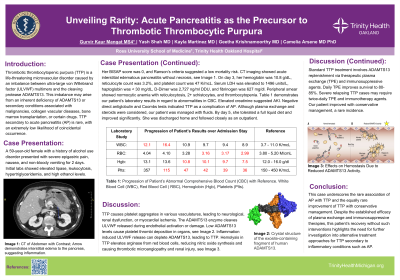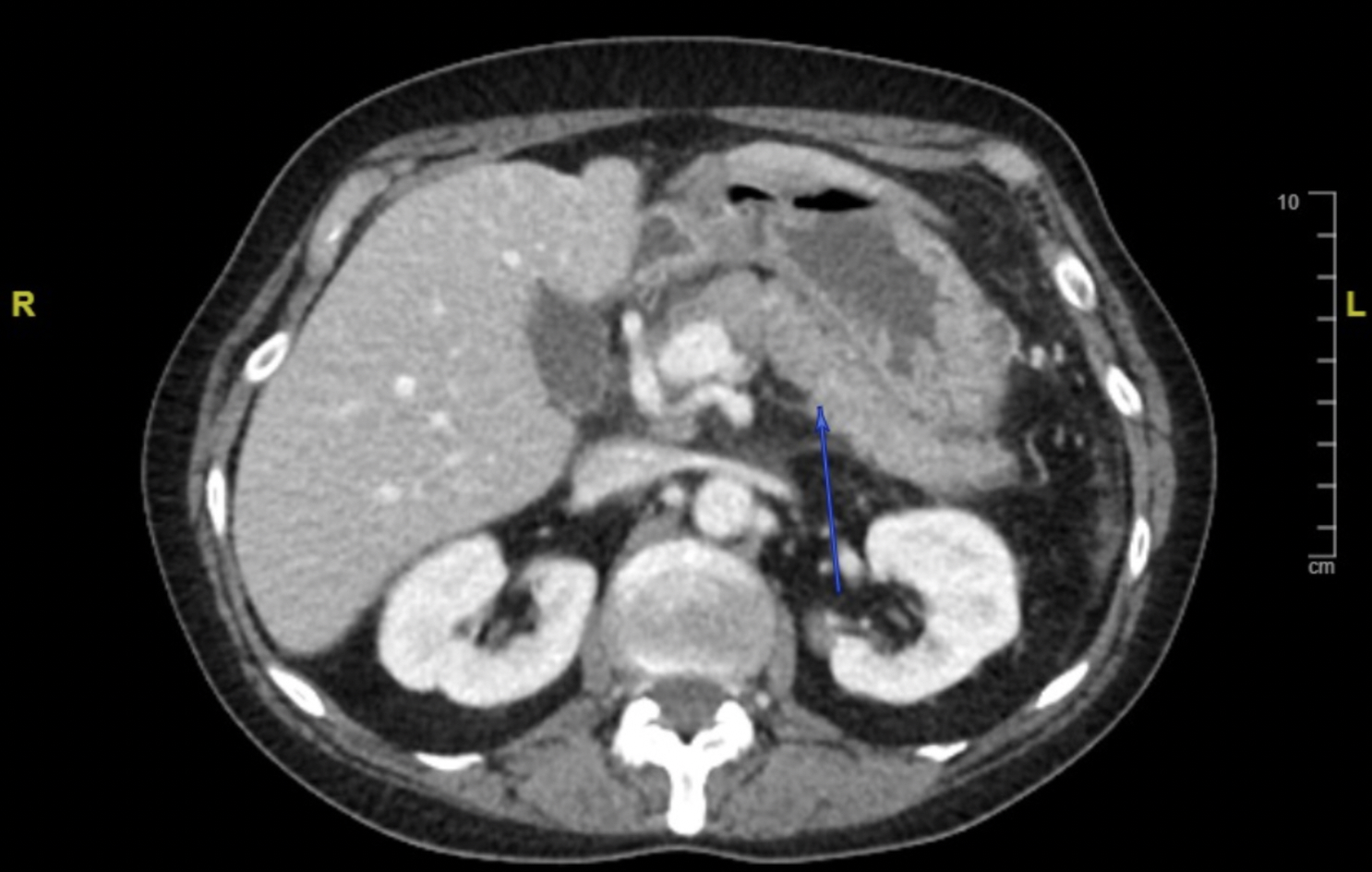Monday Poster Session
Category: Biliary/Pancreas
P1803 - Unveiling Rarity: Acute Pancreatitis as the Precursor to Thrombotic Thrombocytic Purpura
Monday, October 28, 2024
10:30 AM - 4:00 PM ET
Location: Exhibit Hall E

Has Audio

Gurvir Kaur Mangat, MS
Ross University School of Medicine
Pontiac, MI
Presenting Author(s)
Gurvir Kaur Mangat, MS1, Yash Shah, MD2, Kayla Martinez, MD3, Geetha Krishnamoorthy, MD2, Camelia Arsene, MD, PhD2
1Ross University School of Medicine, Pontiac, MI; 2Trinity Health Oakland / Wayne State University School of Medicine, Pontiac, MI; 3Detroit Medical Center/Wayne State University, Detroit, MI
Introduction: Thrombotic thrombocytopenic purpura (TTP) is a life-threatening microvascular disorder caused by an imbalance between ultra-large von Willebrand factor (ULVWF) multimers and the cleaving protease ADAMTS13. This imbalance may arise from an inherent deficiency of ADAMTS13 or secondary conditions associated with malignancies, collagen vascular diseases, bone marrow transplantation, or certain drugs. TTP secondary to acute pancreatitis (AP) is rare, with an extremely low likelihood of coincidental occurrence.
Case Description/Methods: A 59-year-old female with a history of alcohol use disorder presented with severe epigastric pain, nausea, and non-bloody vomiting for 2 days. Initial labs showed elevated lipase, leukocytosis, hypertriglyceridemia, and high ethanol levels. Her BISAP score was 0, and Ranson’s criteria suggested a low mortality risk. CT imaging showed acute interstitial edematous pancreatitis without necrosis, see Image 1. On day 3, her hemoglobin was 10.8 g/dL, reticulocyte count was 3.2%, and platelet count was 47 K/mcL. Serum LDH was elevated to 1496 units/L, haptoglobin was < 30 mg/dL, D-Dimer was 2,727 ng/ml DDU, and fibrinogen was 627 mg/dl. Peripheral smear showed normocytic anemia with reticulocytosis, 2+ schistocytes, and thrombocytopenia. Table 1 demonstrates our patient’s laboratory results in regard to abnormalities in CBC. Elevated creatinine suggested AKI. Negative direct antiglobulin and Coombs tests indicated TTP as a complication of AP. Although plasma exchange and steroids were considered, our patient was managed with fluids. By day 5, she tolerated a full liquid diet and improved significantly. She was discharged home and followed closely outpatiently.
Discussion: TTP causes platelet aggregates in various vasculatures, leading to neurological, renal dysfunction, or myocardial ischemia. The ADAMTS13 enzyme cleaves ULVWF released during endothelial activation or damage. Low ADAMTS13 levels cause platelet thrombi deposition in organs. Inflammation-induced ULVWF release can deplete ADAMTS13, leading to TTP. Hemolysis in TTP elevates arginase from red blood cells, reducing nitric oxide synthesis and causing thrombotic microangiopathy and renal injury. Standard TTP treatment involves ADAMTS13 replenishment via therapeutic plasma exchange (TPE) and immunosuppressive agents. Daily TPE improves survival to 80-85%. Severe relapsing TTP cases may require twice-daily TPE and immunotherapy agents. Our patient improved with conservative management, a rare incidence.

Note: The table for this abstract can be viewed in the ePoster Gallery section of the ACG 2024 ePoster Site or in The American Journal of Gastroenterology's abstract supplement issue, both of which will be available starting October 27, 2024.
Disclosures:
Gurvir Kaur Mangat, MS1, Yash Shah, MD2, Kayla Martinez, MD3, Geetha Krishnamoorthy, MD2, Camelia Arsene, MD, PhD2. P1803 - Unveiling Rarity: Acute Pancreatitis as the Precursor to Thrombotic Thrombocytic Purpura, ACG 2024 Annual Scientific Meeting Abstracts. Philadelphia, PA: American College of Gastroenterology.
1Ross University School of Medicine, Pontiac, MI; 2Trinity Health Oakland / Wayne State University School of Medicine, Pontiac, MI; 3Detroit Medical Center/Wayne State University, Detroit, MI
Introduction: Thrombotic thrombocytopenic purpura (TTP) is a life-threatening microvascular disorder caused by an imbalance between ultra-large von Willebrand factor (ULVWF) multimers and the cleaving protease ADAMTS13. This imbalance may arise from an inherent deficiency of ADAMTS13 or secondary conditions associated with malignancies, collagen vascular diseases, bone marrow transplantation, or certain drugs. TTP secondary to acute pancreatitis (AP) is rare, with an extremely low likelihood of coincidental occurrence.
Case Description/Methods: A 59-year-old female with a history of alcohol use disorder presented with severe epigastric pain, nausea, and non-bloody vomiting for 2 days. Initial labs showed elevated lipase, leukocytosis, hypertriglyceridemia, and high ethanol levels. Her BISAP score was 0, and Ranson’s criteria suggested a low mortality risk. CT imaging showed acute interstitial edematous pancreatitis without necrosis, see Image 1. On day 3, her hemoglobin was 10.8 g/dL, reticulocyte count was 3.2%, and platelet count was 47 K/mcL. Serum LDH was elevated to 1496 units/L, haptoglobin was < 30 mg/dL, D-Dimer was 2,727 ng/ml DDU, and fibrinogen was 627 mg/dl. Peripheral smear showed normocytic anemia with reticulocytosis, 2+ schistocytes, and thrombocytopenia. Table 1 demonstrates our patient’s laboratory results in regard to abnormalities in CBC. Elevated creatinine suggested AKI. Negative direct antiglobulin and Coombs tests indicated TTP as a complication of AP. Although plasma exchange and steroids were considered, our patient was managed with fluids. By day 5, she tolerated a full liquid diet and improved significantly. She was discharged home and followed closely outpatiently.
Discussion: TTP causes platelet aggregates in various vasculatures, leading to neurological, renal dysfunction, or myocardial ischemia. The ADAMTS13 enzyme cleaves ULVWF released during endothelial activation or damage. Low ADAMTS13 levels cause platelet thrombi deposition in organs. Inflammation-induced ULVWF release can deplete ADAMTS13, leading to TTP. Hemolysis in TTP elevates arginase from red blood cells, reducing nitric oxide synthesis and causing thrombotic microangiopathy and renal injury. Standard TTP treatment involves ADAMTS13 replenishment via therapeutic plasma exchange (TPE) and immunosuppressive agents. Daily TPE improves survival to 80-85%. Severe relapsing TTP cases may require twice-daily TPE and immunotherapy agents. Our patient improved with conservative management, a rare incidence.

Figure: Image 1: CT of Abdomen with Contrast; Arrow demonstrates interstitial edema to the pancreas, suggesting inflammation.
Note: The table for this abstract can be viewed in the ePoster Gallery section of the ACG 2024 ePoster Site or in The American Journal of Gastroenterology's abstract supplement issue, both of which will be available starting October 27, 2024.
Disclosures:
Gurvir Kaur Mangat indicated no relevant financial relationships.
Yash Shah indicated no relevant financial relationships.
Kayla Martinez indicated no relevant financial relationships.
Geetha Krishnamoorthy indicated no relevant financial relationships.
Camelia Arsene indicated no relevant financial relationships.
Gurvir Kaur Mangat, MS1, Yash Shah, MD2, Kayla Martinez, MD3, Geetha Krishnamoorthy, MD2, Camelia Arsene, MD, PhD2. P1803 - Unveiling Rarity: Acute Pancreatitis as the Precursor to Thrombotic Thrombocytic Purpura, ACG 2024 Annual Scientific Meeting Abstracts. Philadelphia, PA: American College of Gastroenterology.
